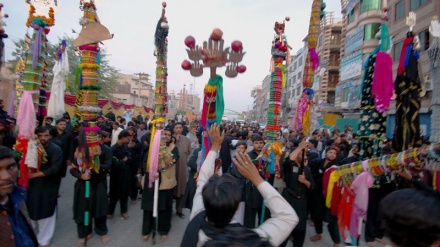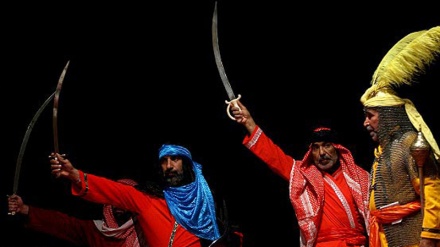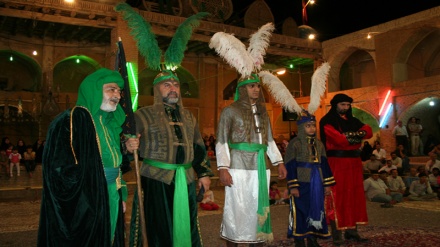Muharram mourning traditions in different lands - 10
Welcome to the 10th part of the 40-plus episodes of a new and interesting series titled “Muharram mourning traditions in different lands”.
Welcome to the 10th part of the 40-plus episodes of a new and interesting series titled “Muharram Mourning Traditions in Different Lands” that we started broadcasting as of October 15 on a daily basis, to commemorate the heartrending tragedy of Karbala, and the martyrdom of Imam Husain (AS), the grandson of Prophet Mohammad (SAWA). In this series, which delves into the various mourning traditions associated with the Immortal Epic of Ashura in various lands, we look at the earliest history of mourning for Imam Husain (AS).
As we said in the previous episode, the Infallible Imams always encouraged Azadari or mourning ceremonies for the Martyrs of Karbala, so that it could become an institution for the believers during the long and lengthy major occultation of the Prophet's 12th and Last Infallible Successor, Imam Mahdi (AS), who by the Will of God will appear in the end times to avenge the innocent blood of Imam Husain (PuH) and to establish the global government of peace and justice. The Imams saw in Azadari not only a demonstration of grief for the martyrs of Karbala but also a renewal of one's commitment to Allah and His laws as expounded in the Holy Qur'an and the Prophet's sayings.
Thus, with the end of the minor occultation of the Imam of the Age and the start of the major occultation, from 329 AH onwards the ulema and jurisprudents took it upon themselves to perpetuate the message of Karbala. Around 333 AH, with the peaceful takeover of Baghdad by the Iranian general Moiz od-Dowla Daylami, Ashura or the 10th of Muharram was for the first time in history declared a public holiday to commemorate the Tragedy of Karbala. In 351 AH on the 10th of Muharram, there was a huge procession in the streets of Baghdad with thousands of men, women and children beating their chests, reciting elegies and chanting “Ya Husain! Ya Husain!” Soon this public commemoration of the Tragedy of Karbala spread to other places in Iraq, to the Syrian city of Aleppo, to Egypt and North Africa, to the cities of Iran, to Central Asia, and to parts of the Subcontinent. A few decades later with the arrival of the Fatemids in Egypt and the building of Cairo, commemoration of the epic of Ashura became institutionalized in Egypt.
The celebrated Iranian scholar, Ibn Babawayh al-Qommi better known as Shaikh as-Sadouq who died in 381 AH was the first scholar to have introduced prose as medium of conveying the message of Imam Husain (AS). He would sit on a pulpit and speak extempore while many of his students sat by the side of the pulpit and recorded the speech. His speeches have been preserved and to this day are known as the Amaali (or dictations). The Majlis al-Husain or Azadari evolved into an institution for the fundamental Islamic principles of Enjoining Good and Forbidding Evil, as well as for renewing allegiance to the ideal of Imam Husain (AS).
As Islam spread, different cultures adopted different modes of Azadari. In Iran, the Taziya or the dramatic staging of the events of Karbala, in order to inculcate in the onlookers the magnitude of the tragedy that befell the Prophet’s household, became an institution. Ta'ziya, which word is derived from the Arabic Aza and means mourning, but through enactment of the tragedy with actors transmitting the message of Karbala to the weeping audiences. It spread all over Iran, as well as Iraq, and parts of the Arab lands under Iranian influence, such as Bahrain, eastern coast of the Arabian Peninsula, and parts of Syria and what is now Turkey.
The Turkic conqueror of Iran, India, and other lands, Amir Taimur, introduced the institution of tabaut or coffin and alam or standard in India. As Islam spread southwards on the subcontinent, the form underwent changes to take into account local cultural influences so as to portray the message of Karbala in the medium best understood by the local people, both Muslims and non-Muslims. By the beginning of the 19th century, there was not a corner of the world, from Spain to Indo-China, which did not have some form of public commemoration of the Tragedy of Karbala.
In Iran, Iraq, the Subcontinent, and Arab Lands, in addition to the Majales-e Aza, the most popular form is dasta or procession of mourners marching on the streets. The dasta in Moḥarram and Ṣafar developed from simple processions into complex rituals. The most notable feature of the dasta is the self-mortification of the participants in tandem with accompanying cymbals and drums. Marchers chant dirges and threnodies, and curse the villains of Karbala. The first recorded public dasta observing the martyrdom of Imam Husain (PuH) took place in Baghdad in the year 352 AH, corresponding to 963 AD. Processions of Shi’a Muslims circulated the city, weeping, wailing, and striking their heads with grief. This ritual quickly spread all over Iran and Iraq, the Arab lands and the Subcontinent. In India, the Ashura processions became part of the Indian Muslim culture. Even the Hindus participated in these processions.
That ends today's episode; don’t forget to tune in tomorrow for the 11th episode of "Muharram mourning traditions in different lands".
MD/AS/EA


